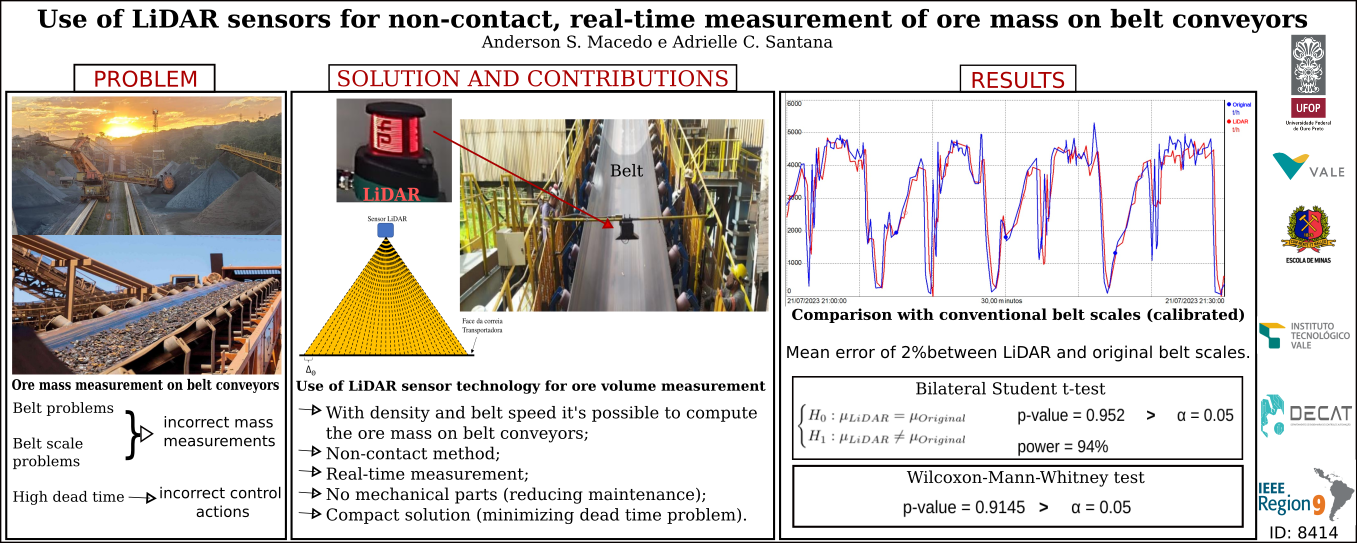Use of LiDAR sensors for non-contact, real-time measurement of ore mass on belt conveyors
Keywords:
LiDAR, Ore Mass, Scales, Conveyor Belts, MeasurementAbstract
This work explores the use of LiDAR sensor technology as a non-contact method for real-time ore mass measurement in ore processing plants. The ore produced is stored in product yards in organized piles based on quality specifications and later transported through a circuit of yard machines, conveyor belts, and a loading silo. After filling the silo, wagons are loaded and their mass is measured using the railway scale. Inventory is determined either by topographical survey or conveyor belt scales. Discrepancies between measurements from belt scales and railway scales can cause inventory breakdown. Furthermore, traditional mass measurement systems have limitations due to physical constraints, besides the need for mechanical adjustments and recalibrations that interrupt processes. To overcome these challenges, this study suggests using LiDAR sensors. The proposed solution involves installing LiDAR sensors over the belt conveyors feeding the loading silo entrance. This allows for real-time integration of the ore area passing through and, with known density, enables the calculation of its volume and mass on the belt. Comparisons between LiDAR measurements and existing scales were statistically tested with field measurements, showing a significant similarity at a 5\% significance level. The results demonstrate that LiDAR technology provides a viable and accurate alternative or complement to traditional mass measurement systems in ore processing plants. This method offers flexibility in installation points, eliminating the need for constant mechanical adjustments and recalibrations, enhancing measurement accuracy in the loading circuit. Furthermore, potential applicability of LiDAR can be extended beyond ore processing.
Downloads
References
P. Kadlec, B. Gabrys, and S. Strandt, “Data-driven soft sensors in the process industry,” Computers & Chemical Engineering, vol. 33, no. 4, pp. 795–814, 2009.
S. G. A. Sobreira, Aplicação de Sensores Virtuais Baseados em Aprendizado de Máquina para Esmava da Vazão Mássica de Minério de Ferro em Correias Transportadoras. Dissertação de mestrado, Universidade Federal de Ouro Preto, Instituto Tecnológico Vale, 2021. Disponível em: https://www.itv.org/wp-content/uploads/2022/02/Dissertacao-Sandro-Versao-Final.pdf.
J. M. García, J. L. Martínez, and A. J. Reina, “Bridge crane monitoring using a 3d lidar and deep learning,” IEEE Latin America Transactions, vol. 21, no. 2, pp. 207–216, 2023
L. L. Amorim, F. Mutz, A. F. De Souza, C. Badue, and T. Oliveira Santos, “Simple and effective load volume estimation in moving trucks using lidars,” in 2019 32nd SIBGRAPI Conference on Graphics, Patterns and Images (SIBGRAPI), pp. 210–217, 2019.
S. R. Peruda, E. D. Yong, L. Samaniego, R. P. Dadoy, V. D. Gubatan, and H. J. O. Marinda, “Low-cost stockpile scanner and volume calculator using light detection and ranging device,” in 2021 IEEE 11th International Conference on System Engineering and Technology (ICSET), pp. 50–54, 2021.
H. Weber, “Lidar sensor functionality and variants,” SICK AG in Waldkirch/Germany, whitepaper, vol. 7, 2018. Accessado em 3 Ago 2022.
Pepperl+Fuchs GmbH. 2-D LiDAR Sensor R2000 Measuring Sensors, 2022. Acesso em 23 Jan 2022. Disponível em:
https://files.pepperl-fuchs.com/webcat/navi/productInfo/doct/tdoct6019c_eng.pdf?v=20230403152657.
J. DURBIN and G. S. WATSON, “Testing for serial correlation in least squares regression: I,” Biometrika, vol. 37, pp. 409–428, 12 1950.
J. DURBIN and G. S. WATSON, “Testing for serial correlation in least squares regression: II,” Biometrika, vol. 38, pp. 159–178, 06 1951.
S. S. Shapiro and M. B. Wilk, “An Analysis of Variance Test for Normality (Complete Samples),” Biometrika, vol. 52, p. 591, dec 1965.


